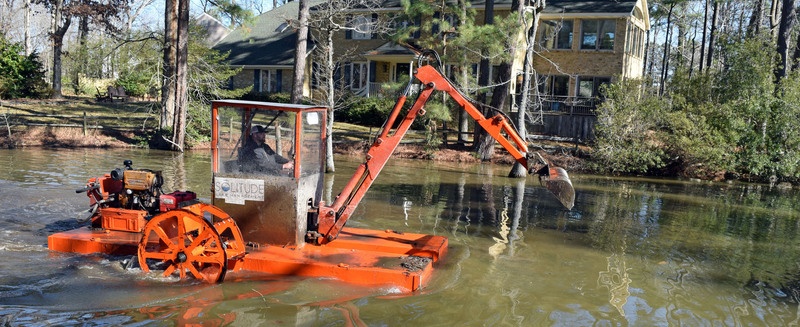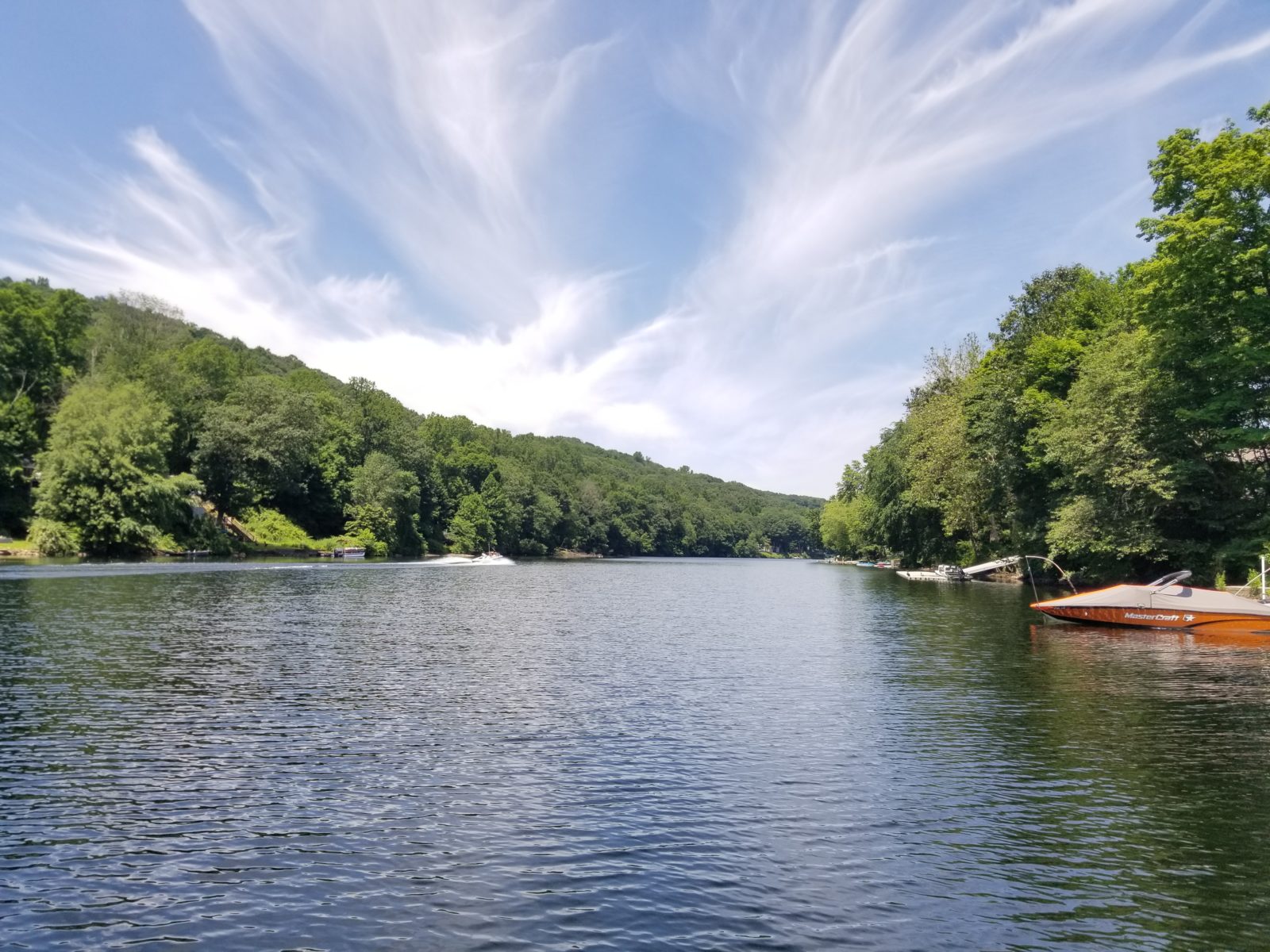Hydro-raking 101: FAQs About Restoring Water & Prolonging Dredging
September 25th, 2018

Everything ages with time. When it comes to your lake or pond, time can take a toll on its health and functionality. Over the lifespan of your waterbody, sediment and organic matter will accumulate, nuisance plants will flourish, water quality will diminish and water depth will decrease. Luckily, you can reverse the aging process and help restore your waterbody back to health with one environmentally-friendly management tool: hydro-raking.
Are you curious whether this is the management solution for you? Below are some of the most popular questions from our recent hydro-raking webinar hosted by industry experts Joe Onorato, Aquatic Specialist & Business Development Consultant; Jeff Castellani, Director of Mechanical Operations and Keith Gazaille, Aquatic Ecologist & Director of Lake Management for the North and Mid-Atlantic.
Is hydro-raking a good option for removing the following aquatic plants: milfoil, waterlilies, cattails and hydrilla?
Like any other aquatic plant management technique, there are situations that favor or limit the use of hydro-raking as an effective tool. It’s importantto have a sound understanding of target plant species, management goals, and conditions in order to properly evaluate the efficacy of implementing hydro-raking. Typically, hydro-raking is used to remove any plants with large, defined root structures, like waterlilies or cattails. Hydro-raking allows multiple years of plant control due to the removal of the full plant, including the root structure. On the other hand, hydro-raking is not usually recommended for the removal of submersed plant species that reproduce through fragmentation, like milfoil and hydrilla, because those species can clone themselves from small fragments left in the water column.
Can hydro-raking help reduce algae and aquatic plant growth in my pond?
A primary benefit unique to hydro-raking is that it removes the entire plant biomass that would ordinarily annually die off and decompose in the system, thus reducing the amount of available pond nutrients that could potentially spur the growth of additional plants and algae.
Is it possible that hydro-raking could actually spread invasive plants throughout the waterbody? What are the sterilization measures for moving the hydro-rake and other equipment between sites?
If proper precautions are not taken to analyze the plant species present in your waterbody, there is a possibility of spreading them during a hydro-raking operation. In most cases, this can happen when submersed species that reproduce through fragmentation are present, which is why SOLitude generally does not recommend hydro-raking as an effective management tool for submersed aquatic plants. Regardless, our mechanical team is highly experienced in the proper identification of plants and routinely inspects machinery before and after operation to ensure the equipment does not contain nuisance or invasive plant fragments.
Is hydro-raking successful in both small and large ponds? Is the hydro-rake flexible in different environments (waterbody sizes, water depth, water access, time of year, etc)?
Yes, a hydro-rake sits about 18 inches deep in the water and can physically rake up to depths of about 10 feet. Due to a more compact size and a variety of rake options, the hydro-rake is excellent at accessing small, tough to reach places like coves and inlets. It really lends itself to targeted areas with limited impact to non-targeted species and delicate shorelines.
In systems that may have limitations to other management techniques due to the presence of rare or endangered species, hydro-raking is an excellent option for the selective removal of undesirable plants. As for time of year, we typically make our recommendations based on the growth of the targeted plant species or long-term goals for the waterbody, though we can use bathymetric mapping technologies and geographic information systems to guide operations at other times of year.
The bottom composition of the waterbody is also important to note. If there are a lot of large stumps, rocks and boulders that are not a part of the removal, there can be some inability to work around a high density of large materials. However, all of our hydro-rake operators have years of experience, and we routinely overcome impediments by craning the machine into certain waterbodies or unloading, first, onto dry land. Each situation is different, but ultimately, as long as there is no hard ice on the pond, we can probably conduct an operation.
What is the best method of disposal for the hydro-raked material?
The most efficient hydro-raking operations facilitate shoreline disposal, because the hydro-rake has no onboard storage. The site must have a suitable space to accommodate that. In some cases, after de-watering the organic matter, the material can be transported to local composting facilities for final disposal.
Can hydro-raking remove sediment from a lined pond?
The short answer is yes, but there are a lot of variables in play to really determine if the use of the hydro-rake could have undesirable impacts on the system: Is the pond truly perched above the water table? How thick is the lining? What type of liner is it? We would give it a strong maybe – though we have operated in many ponds with liners before.
Ultimately, though, hydro-raking is an excellent option for the removal of sediment. But if you want to remove mass amounts of sediment and organic material, dredging is likely a more effective methodology. Bottom line: The hydro-rake is a versatile machine and can be effective in the removal of sediment, but should not be used as a true dredgi ng alternative. If you have a specific project in mind, it’s worth speaking about your goals with your lake management professional to determine the best option.
What are the permit requirements for the process? Who is responsible for obtaining those permits and are they fairly easy to obtain?
The specific permitting requirements and the complexity of those requirements can vary widely by state and even individual project site. As far as obtaining the permits necessary for conducting a hydro-raking project, individual contracts can be structured any number of ways to suit the client’s specific needs. With that said, SOLitude employs a full staff of environmental scientists, aquatic biologists and ecologists that are capable and experienced with filing these types of permits in many states. Given the variability in permitting, it is best to contact your lake management professional for specific details on the likely permit needs for your project, if any at all.
Are there different size hydro-rakes?
Our rakes are custom built and we have a standard size that we build them. They’re about 9,000 pounds and each consist of a backhoe arm and york rake attachment that we modify for hydro-raking applications. Our hydro-rakes are propelled by paddle-wheels, allowing them to access smaller areas without impacting delicate shorelines.
Can hydro-raking restore a pond bank from erosion damage?
Yes, hydro-raking has been used to restore eroded shorelines. Hydro-raking used in conjunction with other bank stabilization/restoration technologies such as SHORESOX® can facilitate a long-term bank restoration that is easily re-vegetated for a desirable living beneficial buffer system.
Does hydro-raking have any negative effects on fish and aquatic wildlife?
No, the hydro-rake allows fish and wildlife to escape the operation. Turbidity created as a result of the hydro-raking process is very short-lived – it usually settles out within 24 hours. In fact, hydro-raking allows the opportunity to enhance the habitat for wildlife. We’ve completed many projects focused on restoring habitat, such as forming varied depth contours to create different water temperature gradients, improving nesting habitat, and creating better access to the water for various water fowl and animal species.
How much does hydro-raking cost?
Hydro-raking projects vary depending on target plant species and many other factors, but most typically cost around $1,500-$2,000 per day for equipment, plus mobilization and disposal activities. Most projects require at least 40-60 operation hours to effectively rake one acre. Ultimately, we create programs on a case-by-case basis. We always have an initial conversation with the client about the on-water, on-shore and disposal costs. Depending on that conversation, we will either include disposal in the pricing or include it as an option.
Does SOLitude offer hydro-raking services throughout the entire country?
Absolutely! While we do have a limited number of machines operating on a calendar basis, we serve clients throughout the nation. Contact your aquatic specialist to determine the availability of our mechanical division and the best time frame to hydro-rake your waterbody.
Can hydro-raking be included in my annual lake and pond management plan?
Yes! But first, contact your aquatic specialist to determine if hydro-raking is the best option for your aquatic resource.
Contact the experts at 888-480-5253 for all of your lake, pond, wetland and fisheries management needs.
SOLitude Lake Management is a nationwide environmental firm committed to providing sustainable solutions that improve water quality, enhance beauty, preserve natural resources and reduce our environmental footprint. SOLitude’s team of aquatic resource management professionals specializes in the development and execution of customized lake, pond, wetland and fisheries management programs that include water quality testing and restoration, nutrient remediation, algae and aquatic weed control, installation and maintenance of fountains and aeration systems, bathymetry, mechanical harvesting and hydro-raking, lake vegetation studies, biological assessments, habitat evaluations, and invasive species management. Services and educational resources are available to clients nationwide, including homeowners associations, multi-family and apartment communities, golf courses, commercial developments, ranches, private landowners, reservoirs, recreational and public lakes, municipalities, drinking water authorities, parks, and state and federal agencies. SOLitude Lake Management is a proud member of the Rentokil family of companies in North America.










